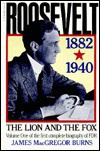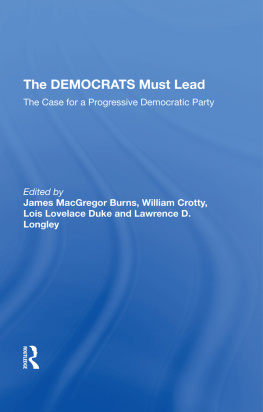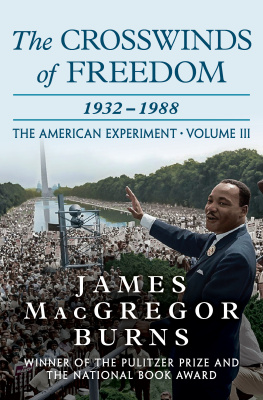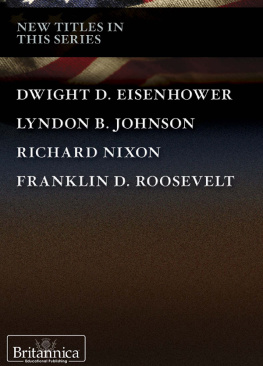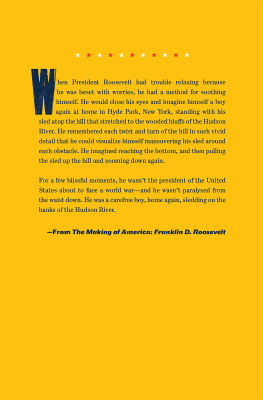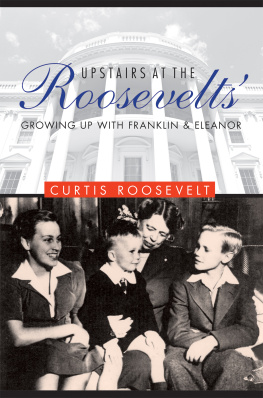
Roosevelt: The Lion and the Fox
By James MacGregor Burns

ILLUSTRATIONS
(Cartoons depicting the Roosevelt era, interspersed throughout the book, are not listed here. All of the photographs are from the archives of the Franklin D. Roosevelt Library at Hyde Park, N. Y.)
THE MOLD OF A HYDE PARK GENTLEMAN
Franklin D. Roosevelt and his father, 1883 Mother and son, 1893
Young Franklin with his grandparents, aunts, uncles, and cousins, Newburgh, N.Y., July 13, 1890
A SECURE WORLD
Three-year-old Franklin and his dog preparing for a ride at Hyde Park
Fourth-string football player at Groton, 1899
A YOUNG LAWYER AND HIS COUSINS
Cousin Eleanor (fifth cousin once removed) in 1906, one year after their marriage
Cousin Jean Delano, sailing at Campobello, around 1910
FAMILY AFFAIRS
Franklin Roosevelt with his wife, his mother, and his daughter, Anna, on
Daisy, the pony, 1911
The family in Washington, 1916Elliott, James, Franklin Jr., John, Anna
Eleanor, with their mother and father
A ROOSEVELT ON THE JOB
His first political post, in the New York Senate, 1911
Assistant Secretary of the Navy at the Navy Yard, New York, 1913
ARMISTICE WITH TAMMANY
Roosevelt with Charles F. Murphy, his old Tammany adversary, and John A. Voorhis at Tammany Hall, July 4, 1917
SOMETHING OF A LION, SOMETHING OF A FOX
The rising politician campaigning for Vice-President on the 1920 Democratic ticketat Dayton, Ohio
On crutches in 1924, with John W. Davis, who won the presidential nomination, and Al Smith, who lost it, after Roosevelts happy warrior speech
A NEW DEAL FOR THE AMERICAN PEOPLE
The Democratic nominee for President arriving by plane in Chicago with his family, July 2, 1932, to address the convention
NOTHING TO FEAR BUT FEAR ITSELF
At the Democratic convention, July 4, 1932, with Louis McHenry Howe and his campaign manager, James A. Farley
The President and his First Lady after arrival in Washington, D. C, March,
1933, before his first inauguration
A MAN OF MANY ROLES
F.D.R. at a dinner for James A. Farley, Feb. 15, 1937, with Henry A. Wallace,
Cordell Hull, and Henry A. Morgenthau
A dismal fishing cruise off Miami during the recession, with Robert H. Jackson,
Harry Hopkins, and Harold Ickes, Nov. 29, 1937
After hot dogs and a picnic at Hyde Park, President and Mrs. Roosevelt wave farewell to the King and Queen of England at the railroad station, June 11, 1939
THE INNER CIRCLE
The President and his secretaries: Marguerite Le Hand, Marvin H. McIntyre, and Grace Tully, Hyde Park, Nov. 4, 1938
The President and his cabinet: Henry A. Morgenthau, Secretary of the Treasury; Homer S. Cummings, Attorney General; Claude Swanson, Secretary of the Navy; Henry A. Wallace, Secretary of Agriculture; Frances Perkins, Secretary of Labor; Harry H. Woodring, Secretary of War; Cordell Hull, Secretary of State, Sept. 27, 1938
THE CHAMP
The campaign, 1932
The press, aboard campaign train, Sept. 13, 1932
The crowds, at Newburgh, N. Y., Nov. 4, 1940
The polling booth, with his wife and mother at Hyde Parks Town Hall, Nov. 8, 1938
The inauguration, Chief Justice Charles Evans Hughes administering the oath of office, Jan. 20, 1937
THE ROOSEVELT SMILE
A drought yearbut when Roosevelt spoke, it rainedCharlotte, N. C, Sept.
10, 1936
Roosevelt laughing at his crippled legs to put others at ease, Hollywood Bowl, Sept. 24, 1932
NEVER A MAN WHO WAS LOVED AS HE IS
At Warm Springs, Ga., Dec. 1, 1933
COMMANDER IN CHIEF
The President reviewing the fleet from the U.S.S. Houston at San Francisco, July 14, 1938
A prince, wrote Machiavelli, must imitate the fox and the lion, for the lion cannot protect himself from traps, and the fox cannot defend himself from wolves. One must therefore be a fox to recognize traps, and a lion to frighten wolves. Those that wish to be only lions do not understand this. Therefore, a prudent ruler ought not to keep faith when by so doing it would be against his interest, and when the reasons which made him bind himself no longer exist. If men were all good, this precept would not be a good one; but as they are bad, and would not observe their faith with you, so you are not bound to keep faith with them.
For
Jan
David
Timothy
Deborah
Antonia
PREFACE
THIS BOOK IS, FIRST of all, a political biography of Franklin D. Roosevelt. It treats much of his personal as well as his public life, because a great politicians career remorselessly sucks everything into its vortexincluding his family and even his dog. How did Roosevelt become what he was? Why was he so effective in winning power? How strong a leader was he in the long run? Where did he fail, and why? What meaning does his life hold for Americans and for American statecraft today?
This book is also a study in political leadership in the American democracy. It focuses chiefly on the man, but it treats also the political context in which he acted, for my approach is based on the central findings of social scientists that leadership is not a matter of universal traits but is rooted in a specific culture. We can understand Roosevelt as a politician only in terms of his political, social, and ideological environment, the way he shaped his society and in turn was shaped by it.
Roosevelt was one of the master politicians of his time, certainly the most successful vote getter. His political artistry grew out of long experience with the stuff of American politics: mens ambitions, fears, and loyalties operating through conventions, primaries, elections, offices, constitutions, opinion agencies. Hence this book is concerned with political methods in the United States.
But methods are not enough. What are the ends to which the methods are geared? This is a central question in regard to Roosevelt. Politics is, among other things, the art of compromise; but should the democratic politician compromise with questionable forces to attain a high good? The democratic politician must win elections; but what if he makes concessions in seeking votes that gravely imperil his chance of putting through his program? In this era of Machiavellians, must the democratic politician act as the fox? To what extent can he take the posture of the lion?
Roosevelt won brilliant victoriesyet during his second term he became ensnarled in forces he could not control and thwarted by men he could not master. That term is, I think, by far the most significant phase of his career. It not only throws light on Roosevelts personality, on his improvising and the implications of that improvising, but it raises the more fundamental question of whether the American political system can meet the crises imposed on it by this exacting century. So this book, finally, is an effort to probe the inner workings of personality and politics in order to throw some light on current problems of political leadership.
Any biographer undertaking at this time to treat Roosevelts whole life faces a dilemma. The war years represented the culmination for both Roosevelt and his country of so much that went before that they deserve full attention; unhappily, scholars as yet do not have the records, memoirs, and other data necessary for a full account and analysis. I have tried to meet this dilemma by treating the war years synoptically and by presenting in the Epilogue and elsewhere an estimate of Roosevelts character that may help explain his handling of certain war problems as well as the nature of his earlier leadership. The full account of the war years must wait.
Next page
